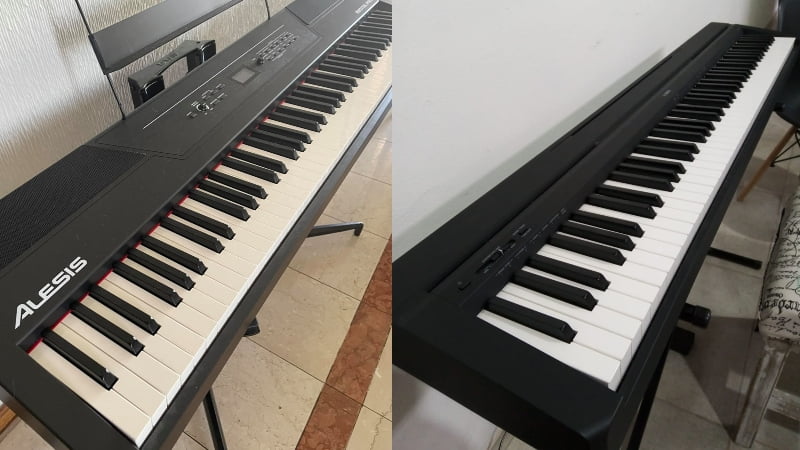Since the Alesis Recital Pro and the Yamaha P45 are some of the most popular entry-level pianos on the market today, creating this Alesis Recital Pro vs Yamaha P45 comparison was a no-brainer. And after tons of research and trying out the pianos myself, I found out a couple of interesting things.
First things first, I found the Alesis Recital Pro to be the better piano overall. It had better tones and a much wider set of piano features that made it a top beginner’s piano. On top of that, it comes with all the accessories you’ll need to start playing.
And while I found that the Yamaha P-45 was lacking in terms of the sound library and features, the quality of the voices was undeniable. Additionally, the Yamaha P-45 sports the Graded Hammer System of Yamaha, which is known to provide a really realistic feel comparable to an acoustic piano.
Alesis Recital Pro vs Yamaha P45: Comparison Chart




Last update on 2025-04-13 / Affiliate links / Images from Amazon Product Advertising API
Alesis Recital Pro vs Yamaha P45: The Differences
To determine the winner between these two pianos, I decided to create a head-to-head comparison of all the different features. And after taking into account customer reviews, comments, and my own thoughts on these two instruments, the Alesis Recital Pro came out the winner with a score of 2-1. In the end, the Alesis model boasted more robust features and a wider variety of tones, which the Yamaha P-45 simply could not keep up with.
Feel & Playability
The winner: Yamaha P-45
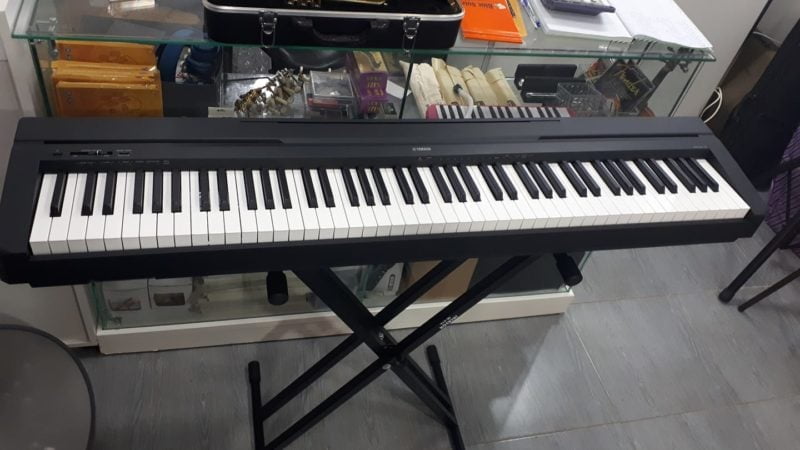
In terms of the feel of the pianos, I have to say that the Yamaha P-45 did offer slightly more realistic hammer action. While both of the pianos have glossy keys which is a major letdown for some pianists, the GHS hammer action of the Yamaha is almost unmatched, especially in this price range, which is why the Yamaha P-45 was the clear winner in this regard.
+ Hammer Action
The Yamaha P-45 sports the Yamaha Graded Hammer System (GHS). This is widely known in the piano community as one of the best hammer action systems out there. Yamaha’s GHS is set up the same way as an acoustic piano, with heavier bass keys on the left that get progressively lighter as you move higher up on the keyboard. For its price, the Yamaha P-45 has great hammer action, which is virtually unmatched in its price range. So, if you’re looking for realistic hammer action for your digital piano, the P-45 might have what you need.
With all that said, the Alesis Recital Pro also has decent hammer action. It’s also progressive, so it mimics a real acoustic piano just like the Yamaha P-45. However, the progressive hammer action on the Recital Pro simply isn’t up to par with the Yamaha P-45, which puts it a step below the Yamaha option.
+ Key Texture
In terms of key texture, both of these pianos left a lot to be desired. This is mainly because the keys have a glossy finish, which is about expected in this price range. With that said, even if I expected glossy keys, that doesn’t mean I wasn’t let down when testing out these pianos. Granted, if you’re a beginner, the glossy texture on the keys won’t make that much of a difference.
However, once you get used to playing acoustic pianos, you will notice a huge difference when shifting to the glossy keys. Additionally, when you start playing faster pieces, you might find it hard to do with the glossy keys on the Yamaha P-45 and Alesis Recital Pro. If I were to change one thing about either of these pianos, I would have added a matte finish or any coating on the keys to resemble and simulate the feel of pressing down on wooden piano keys.
Tone
The winner: Alesis Recital Pro
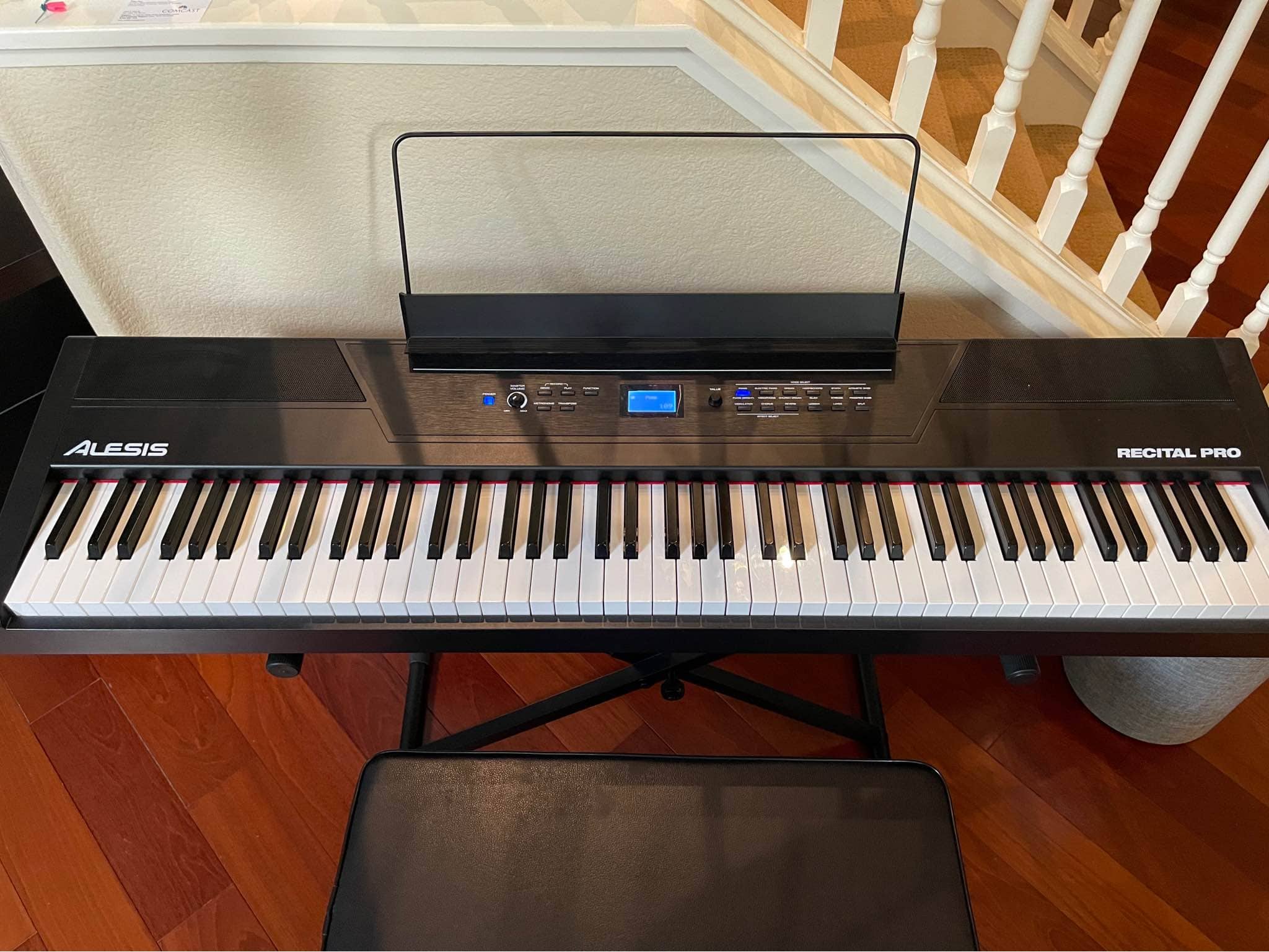
When it came to the tones of these two pianos, I have to say that the fight was close. The Yamaha AWM sampling method is generally hard to beat out in this price range, however, the samples on the Alesis Recital Pro were very high-quality, which evened out the playing field a bit. And in the end, the more varied tone library and voices on the Alesis Recital Pro easily topped the Yamaha P-45.
+ Tone Generation
Both of these pianos use the same kind of tone generation method: sampling. If you want a piano with a digital tone engine, then these aren’t the options for you. Tone engines usually come with steep price tags, so using the sampling technique for developing the tones is one of the reasons both of these models are relatively affordable. With that said, these pianos utilize a fairly unique take on the classic sampling method, which makes for slightly higher quality voices.
To start, the Yamaha P-45 uses the AWM sampling method. AWM stands for “Advanced Wave Memory” and is designed to store more information than standard samples. Yamaha does this by recording their own top-quality grand pianos with the best recording equipment and with natural decay. While these samples will take up more memory, the result is a richer and more realistic tone that better simulates a real acoustic piano.
The Alesis Recital Pro, on the other hand, uses a similar sampling method to produce higher quality tones. It would have been nice if the Recital Pro featured the AiR technology found on more premium Alesis pianos. However, considering the price of the Recital Pro, it’s easy to see why they opted for a more affordable tone generator.
+ Sound Library
While the Yamaha P-45 has a very slight edge when it comes to the tone quality, it’s lacking when it comes to the sound library. The Yamaha P-45 only features 10 different voices. These include grand piano, electric piano, acoustic piano, synth, and bass tones. If you’re a beginner, these are about all the voices you’ll need to learn the instrument, but it admittedly lacks versatility.
The Alesis Recital Pro doesn’t do much better than the Yamaha P-45’s sound library, but it is slightly larger. With the Alesis Recital Pro, you can experiment with 12 different voices that include a church organ and strings. This offers more versatility than the Yamaha P-45, which is a major reason the Alesis Recital Pro is the better option overall. If you’re a beginner pianist, it’s nice to have a variety of different tones for experimentation, allowing you to find just the right voice to suit your playing style and tastes.
Piano Features
The winner: Alesis Recital Pro
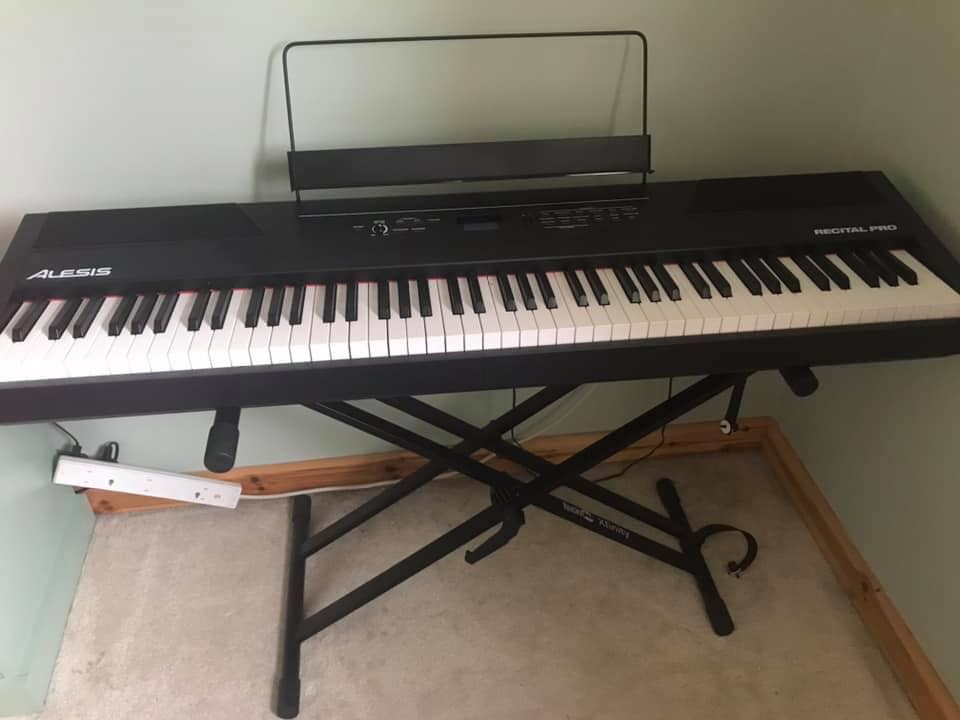
There’s no denying that the Alesis Recital Pro is the superior option when it comes to the different piano features available. Aside from higher maximum polyphony, the Alesis Recital Pro comes with a set of effects and playing modes not available on the Yamaha P-45. And on top of that, the connectivity options on the Alesis Recital Pro far exceed the capabilities of the Yamaha P-45.
+ Polyphony
To start, the Alesis Recital Pro has 128 note maximum polyphony. This is great for its price, and it can even compete with more premium models on the market today. With 128-note polyphony, you have the freedom to play dense and rich chords that are spread out through the keyboard without worrying about a dip in quality or the piano not being able to play the notes. Even if you use the sustain pedal and play melodies over sustained chords, this piano can easily handle the job.
One of the major downsides to the Yamaha P-45 is the 64-note maximum polyphony. If it had the same polyphony as the Alesis Recital Pro, this review might have turned out very different. However, the Yamaha P-45’s polyphony significantly limits what you can do with the instrument, which is a major reason this piano lost out to the Alesis Recital Pro.
+ Effects
The Alesis Recital Pro comes with chorus and reverb effects. Reverb is one of the most useful effects for just about any pianist out there because it can add a lot of depth and richness to the tone. With reverb, you can simulate how a piano will sound in a concert hall, auditorium, and a bunch of other locations. On top of that, if you play in a band or with other musicians, the chorus effect is a great tool to have in your arsenal. With a good chorus effect, you can easily add layers to your music, whether you’re playing chords or a melody.
The Yamaha P-45, on the other hand, only comes with reverb effects. Granted, if you’re a beginner, reverb will be a very useful thing to have, and in reality, it’s the only effect you’ll really need at the start. However, since the Recital Pro comes with a built-in chorus, it allows for more versatility, which is why the Recital Pro came out on top.
+ Playing Modes
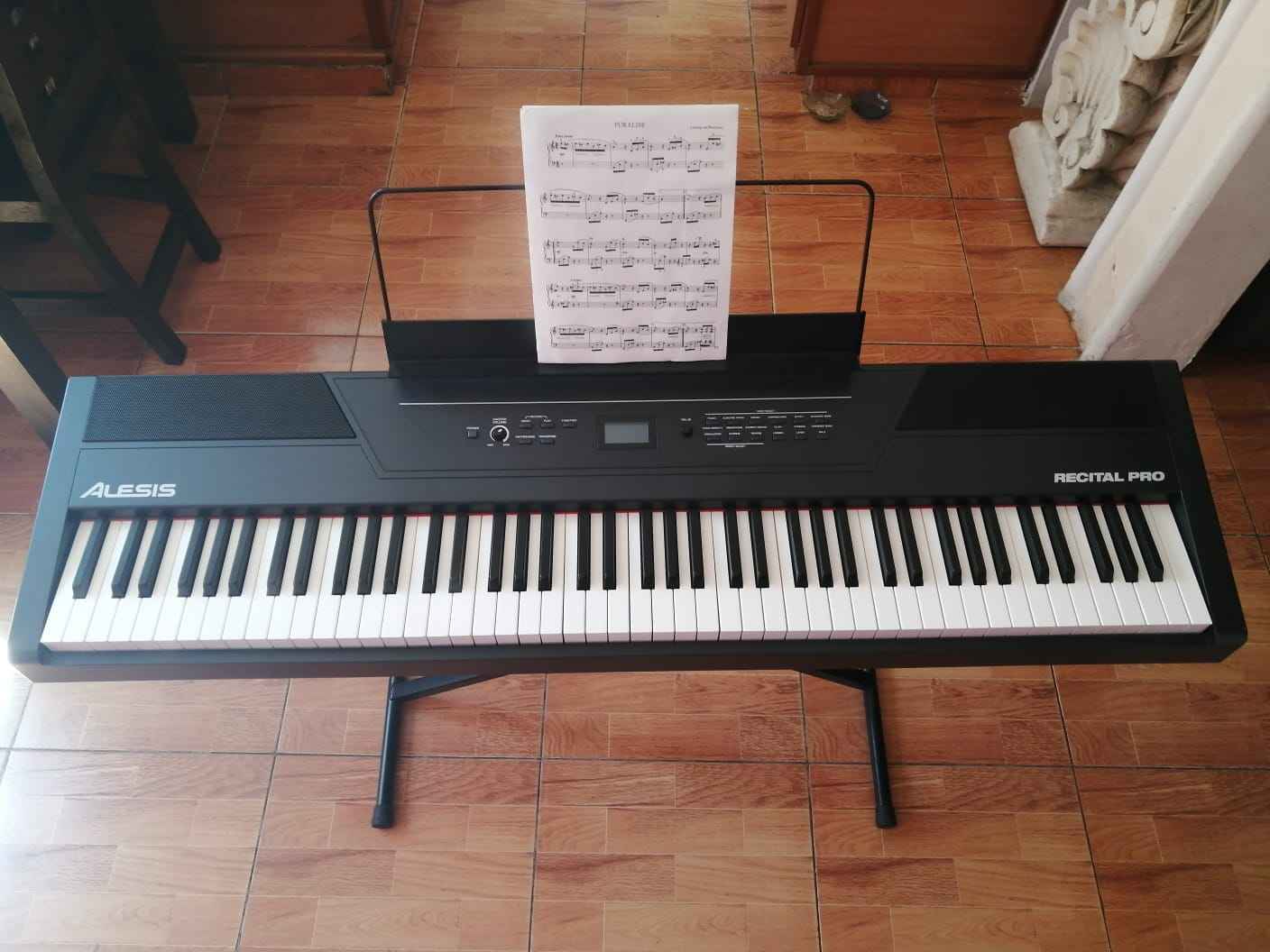
The Alesis Recital Pro has split mode, dual mode, and duo mode. These are the three most important playing modes for any piano student and allows room for experimentation, growth, and can make piano lessons much easier for you. The Yamaha P-45 sports dual and duo mode, which is great, but it doesn’t compare to the recital pro.
With dual mode, you can blend two different voices at the same time. This is great for accompanists as it allows for a richer tone that fills out the space better. However, when you use this mode, you sacrifice a lot of polyphony. Since you play multiple voices whenever you press down on a key, the polyphony is virtually cut in half. So, with the Yamaha P-45, you’ll be left with 32 note polyphony when using dual mode and 64 note polyphony on the Alesis Recital Pro.
Duo mode splits the piano into two mini-keyboards for piano lessons. This is very useful as you don’t have to cross over to the other side of the keyboard when demonstrating something to your teacher and vice versa. The additional playing mode on the Recital Pro is called split mode, and this assigns a different voice to each side of the piano. This gives off the illusion of playing two instruments at once and is a very useful feature for performing pianists.
Alesis Recital Pro vs Yamaha P-45: The Similarities
The major similarity between these two pianos is their target market. Both of the pianos are designed for beginners as their first piano. With that, these are two very affordable pianos with a great set of features that will make learning the piano much easier. So, for less than $500, you get a fully-weighted 88-key keyboard with a variety of high-quality voices and great playing modes.
Both of these pianos also have adjustable touch response. So, whether you have lighter or heavier hands, these pianos will serve you well. Additionally, they both come with sustain pedals to get you started on your musical journey right away.
But in the end, the Alesis Recital Pro does offer much more versatility than the Yamaha P-45. So, if you plan on taking piano seriously and really progressing your skills, the Alesis Recital Pro might serve you much better than the Yamaha P-45.
Quick Rundown of the Alesis Recital Pro
- A Digital Piano That’s Tailored to You - Feature-packed electric keyboard with 88 premium full-sized weighted hammer action keys with adjustable touch response to suit your preferred playing style
- Premium Sounds - 12 voices (Incl. Acoustic Piano, Electric Piano, Organ, Synth, and Bass), built-in FX: Chorus, Modulation, Reverb, and two built in 20W speakers for clear, room-filling sound
- All The Right Connections - ¼” sustain pedal input (pedal not included), ¼” stereo headphone output for private practice and stereo outputs for connection to speakers / amplifiers
- Play the Keyboard Wherever You Go - Power via the included power adapter or 6 D cell batteries (not included) for professional piano performance anywhere
- Powerful Educational Features - Standard, split, layer, record and lesson modes with 128-note max polyphony and Skoove 3 month premium subscription for expert interactive online piano lessons
Last update on 2025-04-13 / Affiliate links / Images from Amazon Product Advertising API
Quick Rundown of the Yamaha P45
- Includes the P45 Digital Piano, power adapter, sustain pedal and music rest
- 88 fully weighted piano style keys simulate the feel of an acoustic piano and provide a quality playing experience
- GHS weighted action is heavier in the low end and lighter in the high end, just like an acoustic piano
- Contains 10 different voices, including digitally sampled tones from real Yamaha acoustic grand pianos
- Dual mode lets you combine 2 voices together, like piano and strings, for an inspiring new playing experience. Tuning- 414.8 - 440.0 - 446.8 Hz
Last update on 2025-04-14 / Affiliate links / Images from Amazon Product Advertising API
Related Articles to Alesis Recital Pro
- Alesis Recital Pro vs Williams Legato III: Discover the Best Piano for Your Home
- Alesis Recital Pro vs Roland Go Piano 88 Comparison: Which Is The Best Portable Digital Piano?
- Alesis Recital Pro vs Yamaha NP32 Comparison: Discover the Best Piano for Your Home
- Kawai ES110 Vs Alesis Recital Pro: Should You Shell Out for the Kawai ES110?
- Alesis Recital Pro vs Prestige Comparison: Choosing the Best Entry-Level Alesis Piano
- Alesis Recital Pro vs Casio CDP-135: Which Is the Best Beginner’s Digital Piano?
- Alesis Recital Pro vs Roland FP-30: Finding the Best Digital Piano on a Budget
- Alesis Recital Pro vs Casio CDP-S150 Comparison: Which Is The Best Portable Digital Piano?
- Alesis Virtue vs Recital Pro: Which Piano Offers The Most For Beginners?
- Alesis Recital Pro vs Casio PX 160: Which Piano Comes Out On Top?
- Alesis Recital Pro vs Roland FP 10: Why You Should Go For The Alesis Recital Pro
- Alesis Recital Pro vs Korg B2 Comparison: Which Digital Piano Should You Get?
- Alesis Recital Pro vs Williams Allegro 3 Comparison: Which One Is Worth Your Money?
- Alesis Recital Pro vs Yamaha P125 Comparison: Which Is The Best Portable Digital Piano?
- Alesis Recital vs Alesis Recital Pro: Should You Invest In The Recital Pro?
- Donner DEP-20 vs Alesis Recital Pro Comparison: Two Great Pianos Designed for Beginners
- Alesis Prestige Artist vs Recital Pro: Which Is the Best Alesis Piano for Beginners?
- Yamaha P71 vs Alesis Recital Pro: Which Digital Piano is the Best Option for Beginners?
Related Articles to Yamaha P45
- Yamaha P45 vs P45B: What’s the Real Difference?
- Yamaha P45 vs DGX-650: Is the DGX-650 Worth the Higher Price?
- Yamaha P-35B vs P45: Finding the Best Affordable Yamaha Piano
- Yamaha P45 Vs DGX-660: A Head-to-Head Comparison
- Yamaha P45 vs Williams Rhapsody II: A Head-to-Head Comparison
- Yamaha P45 Vs NP32: A Head-to-Head Comparison
- Yamaha P45 vs Williams Allegro III: Finding the Best Digital Piano on a Budget
- Yamaha P45 vs YPG 535: Which Is the Best Affordable Yamaha Piano?
- Yamaha P60 vs P45: Finding the Best Yamaha Portable Digital Piano
- Yamaha P45 vs P105: Should You Spend Extra for the P105?
- Alesis Recital Vs Yamaha P45: Which Offers Great Value For Money?
- Donner DEP-10 Vs Yamaha P-45: Which Digital Piano Is Better?
- Yamaha P45 Vs Korg B2: Which Digital Piano Fits Beginners Better?
- Yamaha P45 VS P115: Which P-Series Newbie Gives You More Value for Money?
- Yamaha P45 vs Casio CDP S100: Finding the Better Bet for Beginners
- Yamaha P45 vs YDP 103: Should You Get a Portable or Console Digital Piano?
- Yamaha P45 vs Roland FP10: Which Entry Level Titan Takes the Top Spot?
- Yamaha P45 vs Donner DEP 20: Which Model Is the Better Option for Beginners?
- Yamaha P45 vs Casio PX 770: Should You Get the Portable or Console Digital Piano?
- Alesis Prestige Artist vs Yamaha P45: Can Alesis Hold Its Own Against the Popular Yamaha Model?
- Yamaha P45 vs P125: Why the Yamaha P125 Is the Better Pick for Pianists
- Yamaha P71 vs P45: Why the Amazon Exclusive P71 is the Better Digital Piano
References
- Yamaha P45 from Yamaha: https://usa.yamaha.com/products/musical_instruments/pianos/p_series/p-45/specs.html#product-tabs
- Alesis Recital Pro from Alesis: https://www.alesis.com/products/view/recital-pro
Lulacruza is an electronic folk duo operating at the junction of the hypermodern and the ancient. Our music weaves together hypnotic female singing, South American folk instruments and electronic processing, while channeling pulsating waves from the source of creation.
Lalucruza is also a community where you can connect with other music lovers to collaborate, exchange ideas and share knowledge. A platform for who wants to learns the basics of playing piano, guitar, drum masters’ technique, etc.. is the premise of our website.
